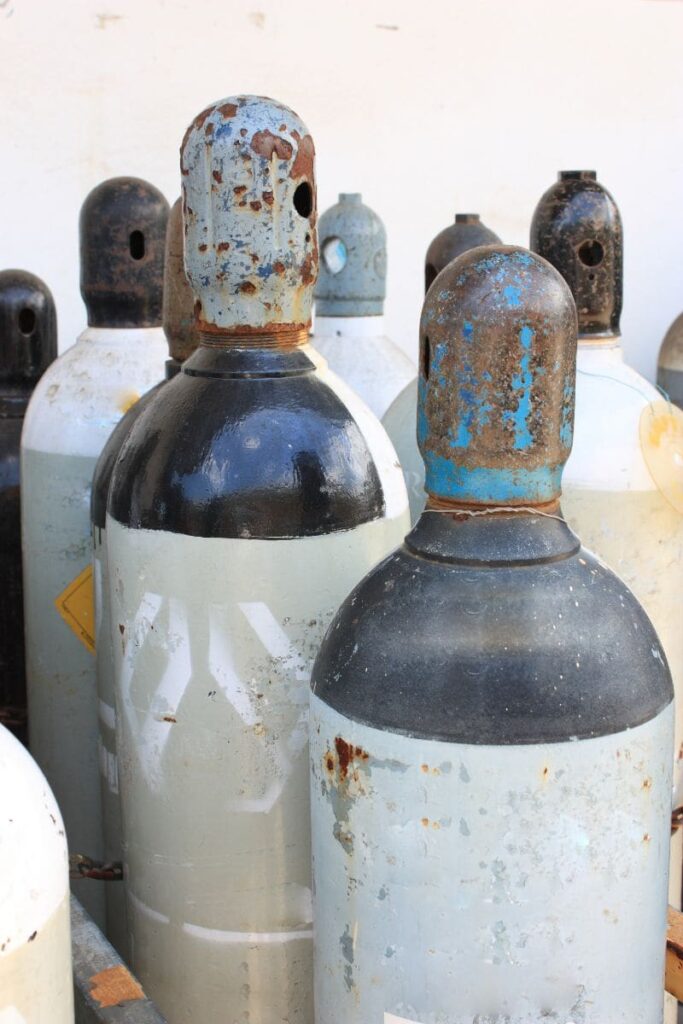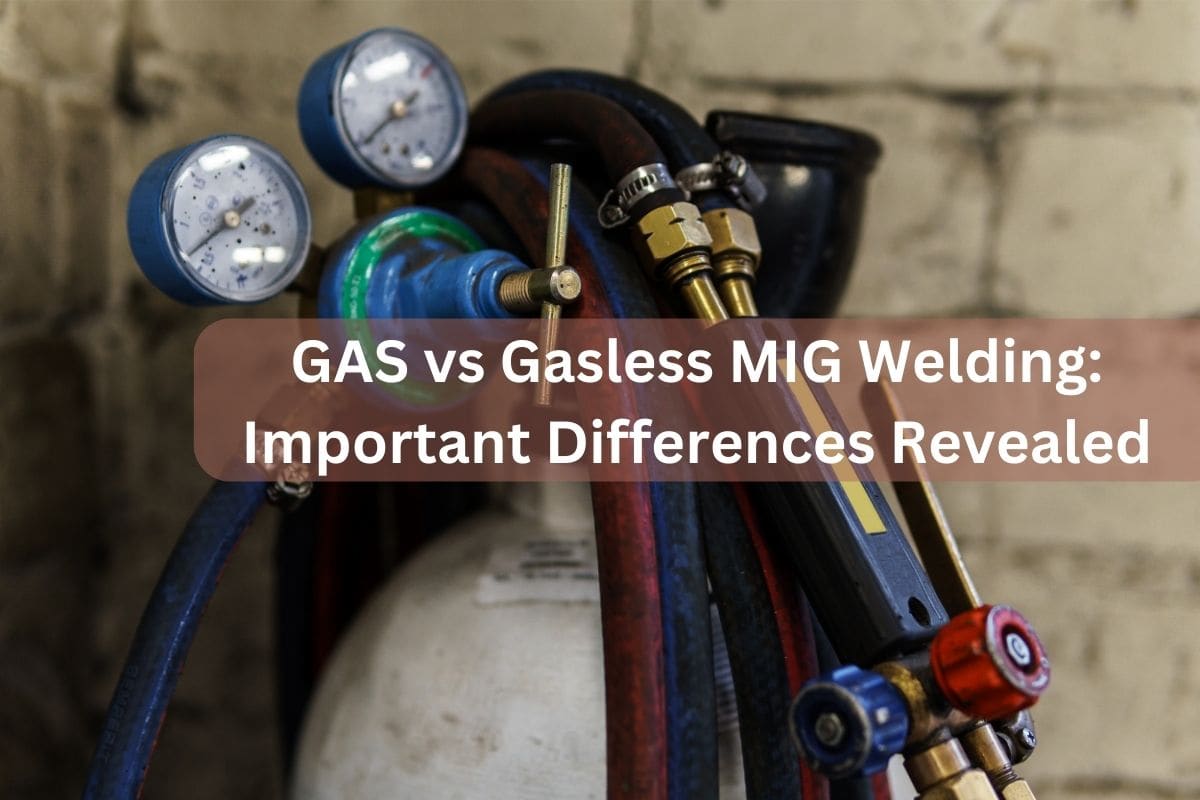GAS vs Gasless MIG Welding – sounds like a boxing match, doesn’t it? But in the world of welding, these are two of the most common techniques you might come across.
Let’s dive deep into understanding these methods and help you pick the champ for your specific needs!
What’s the Difference GAS and Gasless?
To start, let’s clarify the basic difference between the two techniques:
Gas-shielded MIG Welding

This traditional method requires an external shielding gas, usually an ArCO2 mix, to safeguard the weld pool from atmospheric pollutants. When using this technique, the welding rod is gently pushed with positive machine polarity.
Gasless (Self-shielded) MIG Welding
As the name suggests, there’s no external gas. Instead, a special flux-cored filler wire does the shielding. As this flux melts, it releases protective vapors, and a slag layer forms over the metal. Here, the welding rod is pulled (creating a drag) with a negative machine polarity.
Gas-shielded Flux Core
There’s a third player in the game: the gas-shielded flux core. Think of it as a hybrid, requiring gas and forming a slag covering. Not a common choice for hobbyists, but worth knowing about!
Advantages and Disadvantages of GAS vs Gasless MIG Welding
Both techniques come with their unique strengths and challenges. To help you navigate this, we’ve outlined the pros and cons of each method. Equip yourself with this knowledge to make an informed welding decision.
Pros of GAS MIG Welding:
- Precision: Offers more flexibility and precision across various metal types and sizes.
- Reduced Fumes: Produces fewer fumes than its gasless counterpart.
- Clean Weld: Does not leave a slag layer, leading to less post-weld cleanup.
- Metal Versatility: Suitable for a wider range of metals compared to gasless MIG welding.
- Control: Allows for better control over the weld, especially for beginners.
Cons of GAS MIG Welding:
- Portability: Requires a gas cylinder, making it less portable than gasless MIG welding.
- Outdoor Challenges: Windy conditions can be a challenge unless you have protective screens.
- Initial Setup Cost: The requirement for gas can lead to higher initial costs.
- Maintenance: Regular checks on gas levels and potential gas leaks are necessary.
Pros of Gasless MIG Welding:
- Portability: More portable due to the absence of a gas cylinder.
- Outdoor Suitability: Unaffected by wind, making it ideal for outdoor welding.
- Metal Prep: Can weld through paint and rust, though clean metal is always preferred.
- Simplicity: Easier to learn and master, especially for novices.
- Cost-Efficiency: Absence of gas cylinder costs can make it cheaper in the long run.
Cons of Gasless MIG Welding:
- Increased Fumes: Produces more fumes, which can be toxic and may require high-quality respirators.
- Material Limitations: Cannot weld all materials, limiting its versatility.
- Flux Core Concerns: The flux core wire can be easily damaged if not handled properly.
- Cleanup: Leaves a slag layer that needs removal post-welding and can be more prone to spatter.
Read Also : MIG Welding with CO2: Outstanding and Informative Tips
Comparing GAS vs Gasless MIG Welding
When it comes to choosing between GAS vs Gasless MIG Welding, understanding the nuances of each can significantly influence your decision.
Let’s delve into a head-to-head comparison, highlighting the unique characteristics and practical implications of each method.
- The Wire Difference
Both GAS and Gasless MIG employ distinct wire types that play a pivotal role in the welding process. GAS MIG utilizes solid wire spools, characterized by a pushing motion of the gun during welding.
In contrast, Gasless MIG embraces the flux-cored wire spools, where the gun is typically dragged.
GAS MIG, with its precision, is often the preferred choice when working with a variety of metal types. However, Gasless MIG stands resilient against environmental challenges, especially when outdoors.
- Polarity Insights
The polarity used in the welding process holds significant importance. GAS MIG operates on positive polarity (DCEP), ensuring the electrons move from the electrode to the workpiece.
On the flip side, Gasless MIG employs negative polarity (DCEN), causing the electrons to move from the workpiece to the electrode.
Before starting your welding project, taking a moment to verify your machine’s polarity settings can be crucial. A mismatch can compromise the weld’s integrity.
- Navigating Fumes
While both methods involve fume generation, Gasless MIG produces a noticeably higher amount. These fumes, especially when working indoors, emphasize the need for adequate ventilation and the use of high-quality respirators.
- Braving the Great Outdoors
Gasless MIG shines when it comes to outdoor welding, thanks to its inherent ability to withstand windy conditions. With no dependency on external gas, it’s undeterred by wind challenges.
Conversely, if you’re considering GAS MIG for outdoor tasks, be prepared to invest in protective screens to shield against the wind’s effects.
- Ease of Setup & Surface Prep
Gasless MIG’s absence of a gas cylinder accentuates its portability advantage. Moreover, while clean metal is always a welder’s dream, Gasless MIG tends to be more forgiving with slightly unprepared surfaces.
Despite its flexibility, always strive for the cleanest metal surface. It’s a small step that goes a long way in ensuring a robust weld.
- Post-Welding Tasks
A unique trait of Gasless MIG is the slag layer it leaves behind, along with potential spatters. While this means an additional cleanup step, with consistent practice, managing this aspect becomes second nature.
Tips for Choosing GAS vs Gasless MIG Welding
Navigating the decision between GAS vs Gasless MIG Welding can seem intricate. However, armed with a deeper understanding of their unique strengths and practicalities, you can make a well-informed choice.
Let’s break down the essential factors to consider.
- Consider Your Location
The environment where you’ll be welding plays a pivotal role. Gasless MIG stands robust against the challenges of windy outdoor settings, free from the dependencies of external gases.
On the other hand, if you’re inclined towards GAS MIG, you might need to think about protective measures when outdoors, such as shielding screens.
Reflect on the frequency and conditions of your welding tasks. Are you often braving the outdoors or mostly working in controlled indoor settings?
- Type of Metal at Hand
Different metals respond differently to welding techniques. GAS MIG, with its adaptability, offers more precision across a spectrum of metal types. If varied metals are your canvas, GAS MIG might be your best companion.
Familiarize yourself with the metals you work with most often. Each metal has its own temperament, and matching it with the right welding technique can make all the difference.
Read Also : MIG Welding Gas Pressure: Detailed Look into Nozzles
- Budget Constraints
While it’s true that flux-cored wire spools used in Gasless MIG can be on the pricier side, you might find savings in other areas. The absence of recurring gas cylinder costs is a noteworthy saving with Gasless MIG.
Look beyond the immediate costs. Consider long-term expenses, such as gas refills or wire replacements, when setting up your welding budget.
In sum, the GAS vs Gasless MIG Welding debate doesn’t have a one-size-fits-all answer. Instead, weigh the pros and cons, and align them with your specific needs and preferences.
Making the right choice can elevate the quality and efficiency of your welding projects.
Conclusion
GAS vs Gasless MIG Welding isn’t about which is universally better; it’s about what fits best for your situation. Both techniques have their advantages. As with many skills, practice makes perfect.
So, get your helmet on, strike an arc, and discover what works best for you. Remember, every master was once a beginner. Don’t give up, and happy welding!


